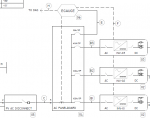kamomeno68
Member
- Location
- Boulder, Colorado, United States
I have a question regarding the requirement that "Each source interconnection of one or more power sources installed in one system shall be made at a dedicated circuit breaker or fusible disconnecting means" (NEC2020 705.12(A) or NEC2017 705.12(B)(1)). My question is generally about the meaning of the word "dedicated". An inspector provided me a photocopy of a page from a John Wiles' article which states, about this code section: "Multiple PV systems may be connected to an existing utility-supplied electrical system, but each connection must be through a dedicated OCPD and a disconnect. 'Dedicated' means that no loads are to be placed on this circuit between the breaker and the PV system ac output." (emphasis mine). I've also seen this perspective expressed by Bill Brooks during a Mike Holt code panel discussion. My specific question is about the meaning of "no loads", and might be best expressed in an example. We design and install commercial pv systems, often with multiple string inverters. The inverter output breakers are usually combined in a single PV AC Aggregation Panelboard, which then connects to the utility-supplied electrical system via a dedicated breaker or fused-disconnect. Most of these projects are designed with a DAS system as well, and that DAS system is powered from a load breaker in the same PV AC Aggregation Panelboard. Depending on the project, there is often another load breaker installed in the PV AC Aggregation Panelboard to feed a service outlet. Here is an example diagram:

Specific questions: (1) Does the presence of the 15A/3P load breaker violate the "dedicated OCPD" requirement? (2) Is the fused AC disconnect the dedicated OCPD, or are the individual inv breakers in the panelboard the dedicated OCPDs? (3) Would the answer change if the panelboard had a MB?

Specific questions: (1) Does the presence of the 15A/3P load breaker violate the "dedicated OCPD" requirement? (2) Is the fused AC disconnect the dedicated OCPD, or are the individual inv breakers in the panelboard the dedicated OCPDs? (3) Would the answer change if the panelboard had a MB?

